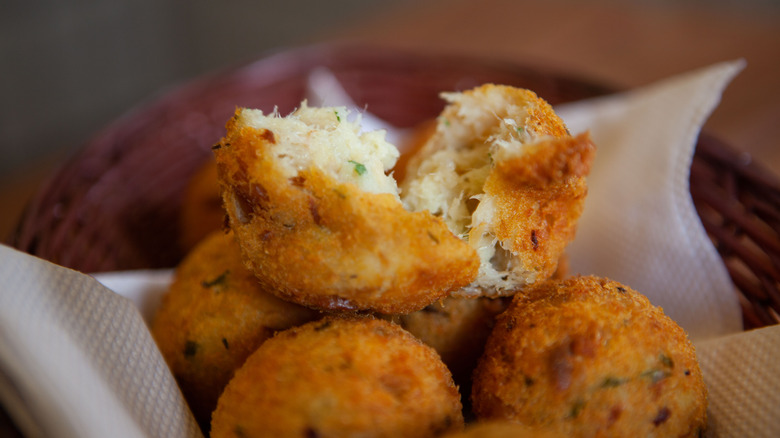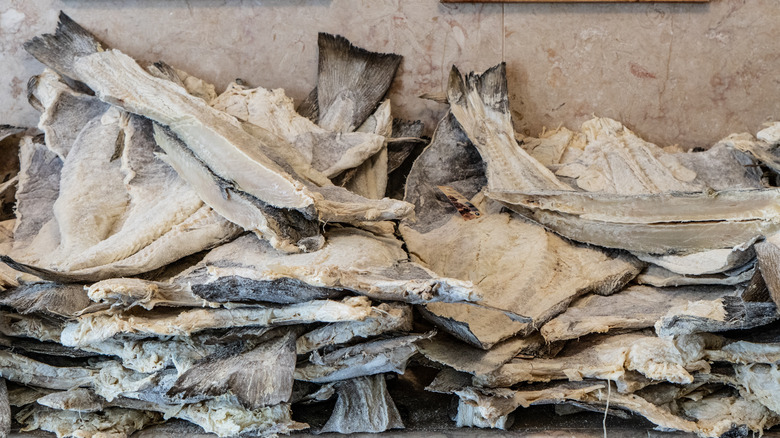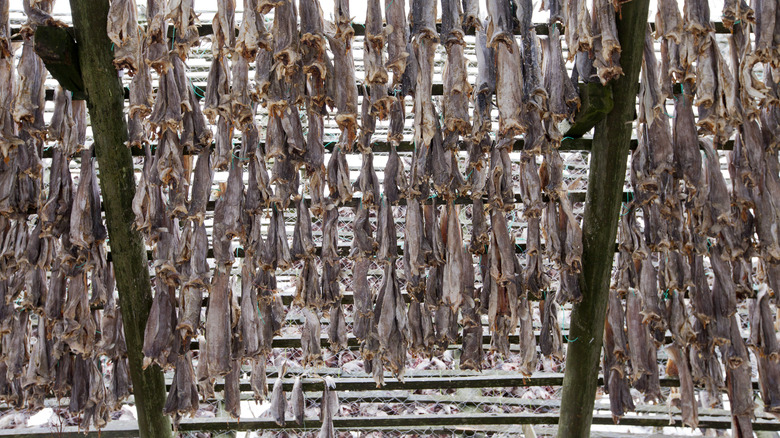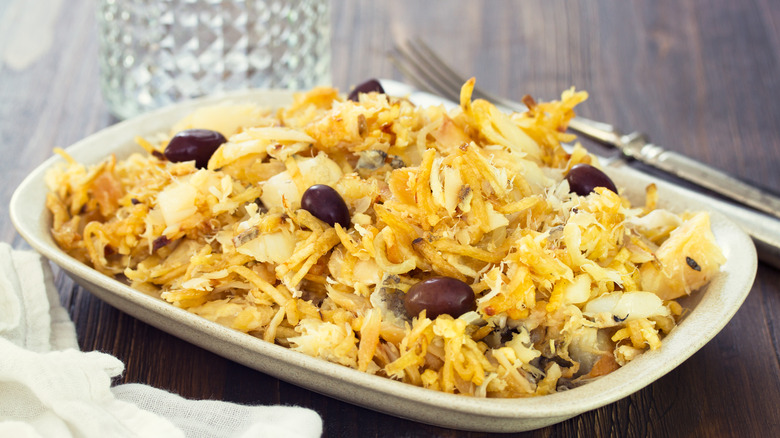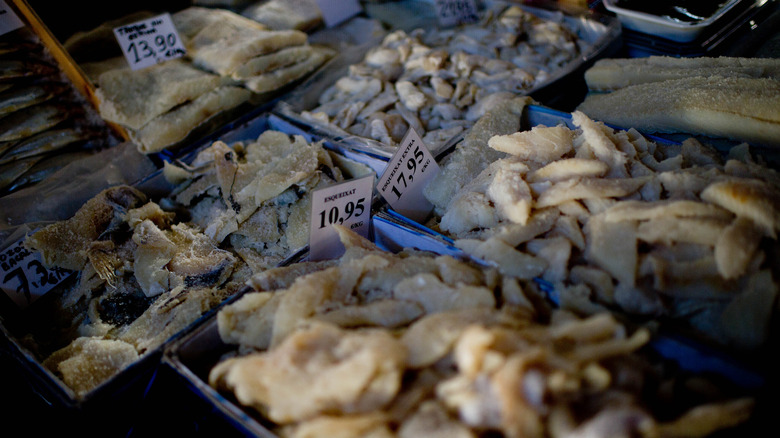The Salted Fish That Plays A Valuable Role In Portuguese Cuisine
Full of vitamins, minerals, and healthy Omega-3 acids, fish is nutritious and tasty. Yet, access to the protein can be tricky for those not close to the coast. Not only does it require speedy transportation to maximize freshness, but high demand for its flavor and health benefits keep prices high, notes Oak and Rowan.
That's where preservation comes in. Throughout Portugal, there is an economically accessible fish source. Known as bacalhau, or salted cod, this centuries-old preservation method eases transportation and sale. Incredibly popular, bacalhau was the dominant form of cod consumed in the Atlantic nation for centuries. Freshly caught cod only started emerging on menus in the last few decades. Even still, bacalhau continues to be king, covering 95% of sales via Portugal.com. Apt for preparation in a myriad of methods, this delectable dried fish is an esteemed component of Portuguese cuisine. Let's dive into what it's all about.
What is bacalhau?
Bacalhau, or dry-salted cod, refers to a salt-curing process applied to three species of fish, Gadus morhua, Gadus macrocephalus, and Gadus ogac. Dehydrated for months, the food is highly functional — simply requiring a 15-minute poach to rehydrate for cooking. Iconic Portuguese fare, the simple salting technique interlinks with centuries of cod-fishing. The curing method enables long transportation so that large volumes of fish can still be consumed after sea crossings from the North Atlantic, notes Food'n Road.
Used in a dizzying variety of cooking methods, a common saying in Portugal is there's a cod preparation technique for every day of the year. Used in celebrated foods like Bacalhau com Natas, a cream-based potato dish, expect bacalhau during festive meals like Christmas. Nevertheless, it doesn't have to be saved for special occasions. With an affordable price, it can also make for an everyday snack, like Pasteis de Bacalhau — scrumptious cod croquettes (via Lisbon Lisboa Portugal).
The fish's simple yet effective processing explains its versatility. Let's dive into how it's made.
How is bacalhau made?
Originally, freshly-caught cod was split in half lengthwise, salted, and then hung by its tail to dry. Wind, sun, and additional salting cured the fish; the elements did most of the work. However, due to the amount of space required to hang the cod, this technique was later adapted for portability. Instead, Portuguese fishermen gutted the fish, salted it, and packed it into crates aboard the fishing vessel. Once shipped to Portugal, the brine was rinsed, and the bacalhau air-dried to completion on shore. This technique is still used in Portugal today, explains We Travel Portugal.
No need to board a Transatlantic fishing vessel to recreate the result. The Spruce Eats offers a salting method replicable at home. Simply bury cod fillets, patted dry, in a generous volume of salt, making sure it's completely covered. Refrigerate for 48 hours, then rinse off the salt, remove any moisture, and dry over a rack in the fridge for up to two weeks. The result will be usable for up to three months — perfect for a range of tasty applications.
How to prepare bacalhau
In an interview by BBC, chef and food writer Leandro Carreira notes how bacalhau is wondrously multi-faceted. Edible and enjoyable when eaten raw, grilled, fried, steamed, or even made into a cake, it's affordable yet dependably delicious.
Any bacalhau preparation starts with rehydrating the fish, which is best done in advance. Take Food and Wine's recipe for Bacalhau à Gomes de Sá, a popular casserole-like dish with potatoes, olives, eggs, and seasoning. The fish is hydrated for 16-48 hours in a refrigerated bowl of water in the fridge. The water is changed out twice during the process. Afterward, the fish is boiled for 10-20 minutes before being mixed with other ingredients in the oven.
The most crucial aspect of cooking with bacalhau is managing its salt content. Since there's a lot of variation from one dried fillet to the next, it's difficult to set one designated hydration time. Instead, cut a piece of hydrating cod, boil, and sample. If it's too saline, keep hydrating. Whenever the bacalhau is too salty at the time of boiling, keep the fish in simmering water for longer, making sure to switch out the water, explains Just Cook with Michael.
How to pick out bacalhau
Buying bacalhau can be the trickiest part of the fish-consuming process. Opt for dried fish sold whole, cut up by the fishmonger, rather than pre-sliced. The various cuts of the fillet are delineated by name. From the prized, thick Lombos cut located in the interior to the small crumbly bits called Migas, make sure to verify which section is necessary for the application. Don't forget to check the appearance, too. The fish should be yellowish in color throughout, without any blood or black markings, reports Portugalist. Never go for a bacalhau that wasn't properly dried. The fish should be firm to the touch and stand up to a dehydration test. Hold the cod by the tail — no folds in the body should occur. Otherwise, it means the moisture content is not suitable for consumption, notes Lugrade.
In Portugal, the fish is widespread, found in the frozen section of supermarkets and in bacalhoaria's — traditional stores (per Taste of Lisboa). Unfortunately, in the U.S., the acquisition is not as effortless. Dried cod can be purchased online, especially in larger quantities by the pound. Alternatively, some groceries also carry imported fish — both inside and out of the freezer.
